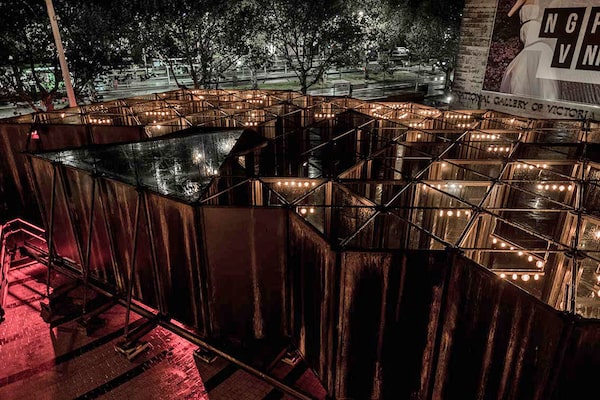Luminato's House of Mirrors has little in common with Yayoi Kusuma’s wildly popular Infinity Mirrors, an AGO exhibition that created a social-media craze last year.Martha Schabas/The Globe and Mail
In Luminato’s House of Mirrors, I took a selfie in which I’m barely visible. Though I faced the mirror head-on, the photograph displays a corridor of zigzagging glass that appears empty for dozens of metres. If you look carefully, there’s a tiny replica of me near its virtual end. When I show people the picture, they have a hard time believing I took it. The physics seem implausible; every reflective surface only serves to push my image farther and farther into the distance.
In an age of selfie-overload, there’s some poetry in this act of diminishment. Designed by Australians Christian Wagstaff and Keith Courtney, the 400-square-metre mirror maze wasn’t conceived with vanity, or Instagram, in mind. Though it’s certainly interactive, it has little in common with Yayoi Kusuma’s wildly popular Infinity Mirrors, an AGO exhibition that created a social-media craze last year, or TIFF’s recent Picture Palace, another prime selfie locale. Instead, there’s a whiff of nostalgia to the enterprise, the labyrinth a throwback to the sort of funhouse, predigital magic that relied solely on optical tricks.
Soaring twelve-feet high and made of 55 tonnes of steel and silverbacked mirrors, the maze’s exterior is foreboding. It will sit in the middle of the Harbourfront Centre grounds until June 23, its open roof subjecting its hallways to all vicissitudes of light and weather. Once you step inside, you won’t be thinking about what you look like. You’ll be much more concerned with keeping your bearings and not becoming so profoundly disoriented that you loop back to the entrance a dozen-odd times.

Soaring 12-feet high and made of 55 tonnes of steel and silverbacked mirrors, the maze’s exterior is foreboding.Remi Chauvin
Created in 2016, the House of Mirrors has already thrilled visitors of all ages in 12 cities. Toronto marks its North American premiere and its first time sitting inside a downtown core. A point of distraction might be the city’s skyline, which is also reflected in the silvery surfaces. Look up and you’ll see the various geometric iterations of glass and concrete that comprise our waterfront’s architecture: the CN Tower, the Power Plant gallery’s 1926 brown-brick smokestack, the Queen’s Quay terminal building. The condo jungle that surrounds Harbourfront is hardly the city’s most attractive neighbourhood and you might find yourself contemplating its appearance, and the symbolism of your tiny self within it, before you give much thought to your own.
A favourite line from the philosopher Jean-Paul Sartre: “If you look in the mirror for too long, you will see a monkey.” I remembered this quote when I left the maze, flipping through the selfies that effectively erased me. Is there a moral lesson in the erasure? Ever since Narcissus died in thrall to his own reflection, vanity has rarely been rewarded in Western culture. Mirrors often play conspiring roles, accomplices to our self-adoration, only to turn against us on a whim. They can’t be trusted, either because they distort our perception of reality or reveal more of it than we’d like to see.
Kira, The Path/La Voie brings the energy to Toronto’s Luminato festival

Don't forget to look up while in the maze.Remi Chauvin/Supplied
There are all kinds of superstitions associated with mirrors, too, as though we instinctively fear their reflective power, whose reliability we both worship and distrust. While the Luminato maze is good family fun, and not half as eerie as these allusions might suggest, it still plays on how easily our eyes can be tricked and how much these tricks intrigue us.
House of Mirrors continues as part of Luminato at Harbourfront Centre Exhibition Common until June 23. $10/Kids under 5 free.
Live your best. We have a daily Life & Arts newsletter, providing you with our latest stories on health, travel, food and culture. Sign up today.